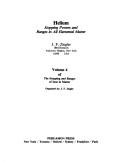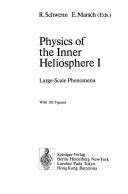| Listing 1 - 7 of 7 |
Sort by
|
Book
Year: 1968 Publisher: Yamato-machi, Saitama: Institute of physical and chemical research,
Abstract | Keywords | Export | Availability | Bookmark
 Loading...
Loading...Choose an application
- Reference Manager
- EndNote
- RefWorks (Direct export to RefWorks)
Book
ISBN: 8773041130 Year: 1981 Publisher: København : Munksgaard,
Abstract | Keywords | Export | Availability | Bookmark
 Loading...
Loading...Choose an application
- Reference Manager
- EndNote
- RefWorks (Direct export to RefWorks)
Helium ions --- Hydrogen ions --- Straggling (Nuclear physics). --- Scattering.

ISBN: 0080216064 9780080216065 Year: 1977 Volume: 4 Publisher: New York (N.Y.): Pergamon,
Abstract | Keywords | Export | Availability | Bookmark
 Loading...
Loading...Choose an application
- Reference Manager
- EndNote
- RefWorks (Direct export to RefWorks)
Stopping power (Nuclear physics) --- Helium ions --- Effective range (Nuclear physics) --- Atomic stopping power --- Average ionization potential --- Kinetic energy of particles (Nuclear physics) --- Stopping cross section --- Collisions (Nuclear physics) --- Ionization --- Matter --- Nuclear reactions --- Particles (Nuclear physics) --- Radioactivity --- Linear energy transfer --- Particle range (Nuclear physics) --- Ions --- Heliosphere (Ionosphere) --- Range, Effective (Nuclear physics) --- Potential scattering --- Properties --- Measurement --- Helium ions. --- Effective range (Nuclear physics). --- Stopping power (Nuclear physics).
Multi
ISBN: 9781461486602 1461486602 Year: 2013 Publisher: New York : Springer,
Abstract | Keywords | Export | Availability | Bookmark
 Loading...
Loading...Choose an application
- Reference Manager
- EndNote
- RefWorks (Direct export to RefWorks)
Helium Ion Microscopy: Principles and Applications describes the theory and discusses the practical details of why scanning microscopes using beams of light ions – such as the Helium Ion Microscope (HIM) – are destined to become the imaging tools of choice for the 21st century. Topics covered include the principles, operation, and performance of the Gaseous Field Ion Source (GFIS), and a comparison of the optics of ion and electron beam microscopes including their operating conditions, resolution, and signal-to-noise performance. The physical principles of Ion-Induced Secondary Electron (iSE) generation by ions are discussed, and an extensive database of iSE yields for many elements and compounds as a function of incident ion species and its energy is included. Beam damage and charging are frequently outcomes of ion beam irradiation, and techniques to minimize such problems are presented. In addition to imaging, ions beams can be used for the controlled deposition, or removal, of selected materials with nanometer precision. The techniques and conditions required for nanofabrication are discussed and demonstrated. Finally, the problem of performing chemical microanalysis with ion beams is considered. Low energy ions cannot generate X-ray emissions, so alternative techniques such as Rutherford Backscatter Imaging (RBI) or Secondary Ion Mass Spectrometry (SIMS) are examined. Serves as a concise but authoritative introduction to the latest innovation in scanning microscopy Compares ion and electron beams as options for microscopy Presents a detailed physical model of ion-solid interactions and signal generation Provides a detailed database of iSE yield behavior as a function of the target ion, element, and energy.
Optics. Quantum optics --- Physics --- Surface chemistry --- Theoretical spectroscopy. Spectroscopic techniques --- Spectrometric and optical chemical analysis --- Materials sciences --- Electrical engineering --- Applied physical engineering --- materiaalkennis --- oppervlakte-onderzoek --- nanotechniek --- spectroscopie --- microscopie --- spectrometrie --- Field ion microscopy. --- Helium ions. --- Ion bombardment.
Book
ISBN: 1461486599 1461486602 Year: 2013 Publisher: New York : Springer,
Abstract | Keywords | Export | Availability | Bookmark
 Loading...
Loading...Choose an application
- Reference Manager
- EndNote
- RefWorks (Direct export to RefWorks)
Helium Ion Microscopy: Principles and Applications describes the theory and discusses the practical details of why scanning microscopes using beams of light ions – such as the Helium Ion Microscope (HIM) – are destined to become the imaging tools of choice for the 21st century. Topics covered include the principles, operation, and performance of the Gaseous Field Ion Source (GFIS), and a comparison of the optics of ion and electron beam microscopes including their operating conditions, resolution, and signal-to-noise performance. The physical principles of Ion-Induced Secondary Electron (iSE) generation by ions are discussed, and an extensive database of iSE yields for many elements and compounds as a function of incident ion species and its energy is included. Beam damage and charging are frequently outcomes of ion beam irradiation, and techniques to minimize such problems are presented. In addition to imaging, ions beams can be used for the controlled deposition, or removal, of selected materials with nanometer precision. The techniques and conditions required for nanofabrication are discussed and demonstrated. Finally, the problem of performing chemical microanalysis with ion beams is considered. Low energy ions cannot generate X-ray emissions, so alternative techniques such as Rutherford Backscatter Imaging (RBI) or Secondary Ion Mass Spectrometry (SIMS) are examined. Serves as a concise but authoritative introduction to the latest innovation in scanning microscopy Compares ion and electron beams as options for microscopy Presents a detailed physical model of ion-solid interactions and signal generation Provides a detailed database of iSE yield behavior as a function of the target ion, element, and energy.
Field ion microscopy. --- Helium ions. --- Ion bombardment. --- Field ion microscopy --- Helium ions --- Ion bombardment --- Chemical & Materials Engineering --- Engineering & Applied Sciences --- Materials Science --- Microscopy. --- Spectrum analysis. --- Analysis, Spectrum --- Spectra --- Spectrochemical analysis --- Spectrochemistry --- Spectroscopy --- Analysis, Microscopic --- Light microscopy --- Micrographic analysis --- Microscope and microscopy --- Microscopic analysis --- Optical microscopy --- Materials science. --- Spectroscopy. --- Nanoscale science. --- Nanoscience. --- Nanostructures. --- Nanotechnology. --- Materials Science. --- Characterization and Evaluation of Materials. --- Spectroscopy and Microscopy. --- Spectroscopy/Spectrometry. --- Nanoscale Science and Technology. --- Optics --- Chemistry, Analytic --- Interferometry --- Radiation --- Wave-motion, Theory of --- Absorption spectra --- Light --- Spectroscope --- Qualitative --- Surfaces (Physics). --- Molecular technology --- Nanoscale technology --- High technology --- Physics --- Surface chemistry --- Surfaces (Technology) --- Spectrometry --- Nanoscience --- Nano science --- Nanoscale science --- Nanosciences --- Science --- Material science --- Physical sciences --- Analytical chemistry
Book
ISBN: 8773040975 Year: 1979 Publisher: Copenhagen Munksgaard
Abstract | Keywords | Export | Availability | Bookmark
 Loading...
Loading...Choose an application
- Reference Manager
- EndNote
- RefWorks (Direct export to RefWorks)
Helium ions --- -Hydrogen ions --- -Stopping power (Nuclear physics) --- Atomic stopping power --- Average ionization potential --- Kinetic energy of particles (Nuclear physics) --- Stopping cross section --- Collisions (Nuclear physics) --- Ionization --- Matter --- Nuclear reactions --- Particles (Nuclear physics) --- Radioactivity --- Linear energy transfer --- Particle range (Nuclear physics) --- Monovalent cations --- Ions --- Heliosphere (Ionosphere) --- Scattering --- Properties --- Measurement --- Hydrogen ions --- Stopping power (Nuclear physics) --- Stopping power (Nuclear physics). --- Scattering.

ISBN: 3540520813 0387520813 038752083X 354052083X 9780387520834 9783540520832 3642753663 3642753647 3642753639 3642753612 Year: 1991 Volume: 20 Publisher: Berlin,New York : Springer-Verlag,
Abstract | Keywords | Export | Availability | Bookmark
 Loading...
Loading...Choose an application
- Reference Manager
- EndNote
- RefWorks (Direct export to RefWorks)
523.9 --- 523.9 The Sun. Solar physics --- The Sun. Solar physics --- Heliosphere --- Interplanetary magnetic fields --- Heliosphere (Ionosphere) --- Interplanetary magnetic fields. --- Interplanetary magnetic field --- Cosmic magnetic fields --- Interstellar medium --- Space environment --- Interstellar reddening --- Helium ions --- Cavity, Solar --- Solar cavity --- Matière interstellaire --- Heliosphere (Astrophysics) --- Interstellar matter. --- Astrophysics --- Matter --- Ionosphere --- Solar wind --- Interstellar matter --- Sun --- Soleil --- Corona --- Couronne
| Listing 1 - 7 of 7 |
Sort by
|

 Search
Search Feedback
Feedback About UniCat
About UniCat  Help
Help News
News